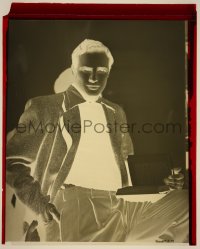eMoviePoster.com
Auction History Result 2s0401 MARLON BRANDO 8x10 studio negative 1950 standing portrait making his first movie, The Men! Date Sold 8/7/2022Sold For: Login or Register to see sold price. A Photographic Negative (measures 8" x 10" [20 x 25 cm]) (Learn More) Marlon Brando was born Marlon Brando, Jr. in Omaha, Nebraska in 1924. His parents were both alcoholics, and his mother was a sometime actress, and Marlon showed acting talent at a young age. His father had graduated from a military academy, and sent Marlon there, and he acted there, but he was suspended in his senior year, and he could have gone back, but he left. His two sisters had moved to New York, one to act, and one to study art, and he followed them there. He studied with Stella Adler, one of the proponents of the Stanislavski System, which wanted actors to literally become the characters they portrayed by thinking exactly as that character would (different from "method" acting, where one uses personal memories to help duplicate the characters thoughts and actions). In 1944, he made his Broadway debut as Nels in I Remember Mama, and he received excellent reviews. He was courted by Hollywood, but refused to sign a contract with any studio. He next appeared in Truckline Cafe on Broadway, and though the play flopped, Brando got great reviews. He next appeared in A Flag is Born about the birth of Israel. The play had just three actors, Brando, Paul Muni and Celia Adler, and they worked for the Actor's Equity rate, because all proceeds went to help Israel. Brando later wrote of being transfixed by Muni's acting ability in this play! Brando next played the lead in A Streetcar Named Desire on Broadway (the part had been first offered to John Garfield, but he demanded a percentage, and after Burt Lancaster also turned it down, Brando was hired). Brando went to Hollywood and starred in The Men, followed by a remarkable string of movies: A Streetcar Named Desire (nominated for the Best Actor Academy Award for this film), Viva Zapata! (nominated for the Best Actor Academy Award for this film), Julius Caesar (nominated for the Best Actor Academy Award for this film), Sayonara (nominated for the Best Actor Academy Award for this film), The Wild One, Dry White Season (nominated for the Best Supporting Actor Academy Award for this film), and On the Waterfront (winner of the Best Actor Academy Award for this film), his greatest role (although the movie was made primarily by those, with the exception of Brando, who had named names or co-operated with the HUAAC hearings, so it was hated by leftists as being a defense of stool pigeons). In the late 1950s, Brando's roles became increasingly odd, and while his performances equaled his earlier ones, the movies did not. He was hired to star in Stanley Kubrick's One-Eyed Jacks in 1961, but fought with Kubrick, who quit, and Brando took over the directing, which resulted in a weird movie that lost a lot of money. After he had a similar experience on Mutiny on the Bounty the following year, Brando's film choices became increasingly stranger. In 1972, Brando's star had sunk so low that he had to audition for the role of Don Corleone in The Godfather (winner of the Best Actor Academy Award for this film), but he was superb, and the movie grossed the most of any movie to that time. After the odd Last Tango in Paris (nominated for the Best Actor Academy Award for this film) the same year, Brando proceeded to do parts solely for the money, such as playing Jor-El in Superman. Brando continued making movies until 2001, and passed away in 2004 at the age of 80. He had a tumultuous personal life, filled with many causes and much drama, and even the death of family members. The great film critic Pauline Kael thought his career was much like that of John Barrymore, in that, after a brilliant stage career and early film career, he squandered much of the rest of his career due to personal excesses. Still, it is hard not to see Brando as likely the finest film actor of the second half of the 20th Century, and his acting style had a huge influence on a high percentage of the actors that followed him. Important Added Info: Note that this is a "studio-issued" negative. What is it? It was produced by the studio but is not the camera original. It is very high quality and was created in quantity by the studios and sent to media outlets or other places that had need of the very highest quality image for reproduction purposes (in newspapers, magazines, or elsewhere). We have put a scan of the negative that shows the "positive image" (in addition to an image of the negative image). REMEMBER THAT WHAT YOU RECEIVE WILL BE A PHOTOGRAPHIC NEGATIVE, NOT A POSITIVE IMAGE LIKE YOU ARE SEEING (however, the archive that owned this made an 8x10 positive print from it that will be included with the negative). However, we will provide the winning bidder of this auction that positive image scan that is both high quality and not watermarked (on request to the winning bidder, and only the winning bidder). The negative is in a plastic sleeve (but we removed it and scanned it, so that bidders could see just how high quality it is). It will be sent to the winner of the auction in its sleeve. Note that this negative (and 96 others we are currently auctioning, in 97 separate auctions) has a wonderful provenance! From 1938 through the 1960s, movie fans would purchase photos of their favorite movie stars from a company in Brooklyn, New York, called "Movie Star News". This company, owned by Irving Klaw, sold a massive number of repro photos, because it became widely known to have some of the highest quality movie star images there were, as good or better than what the studios themselves produced. It turns out that Klaw had obtained the negatives that he made his photos from directly from the major studios, who apparently did not want to store negatives due to the fear of them being a fire hazard. He amassed an unmatched collection of over 20,000 negatives of all the top Hollywood stars, and over half of them were "camera originals", meaning they were the ones in the camera when the photographer took the image, and were hand retouched by the photographer (if retouching was necessary). Irving Klaw died in 1966, and his nephew continued his business for many years, but he closed the business in 2012, and the archive of negatives passed through several hands before being acquired by a company that hired a professional archivist to spend over a year cataloging the negatives. The 97 negatives we are currently auctioning are from this amazing archive, and approximately half of them are camera originals, and half are "studio negatives" (created by the studio directly from the camera original). See above for which type of negative the one in this auction is. These include wonderful images of top Hollywood stars! This is an amazing opportunity to not only purchase ultra rare negatives, but also to obtain ones from one of the most legendary archives ever assembled! Condition: good to very good. There is a piece of thin red tape on three borders. Learn More about condition grades 

Postal Mailing Address:
Bruce Hershenson, P.O. Box 874, West Plains, MO 65775. (For our UPS or FedEx address, click here) phone: +1 417 256-9616 fax: +1 417 257-6948 E-mail: Contact Us Hours of Operation: Monday - Friday 8:30 AM - 12:00 PM & 1:00 PM - 5:00 PM (CST) |
|||||||||||||







